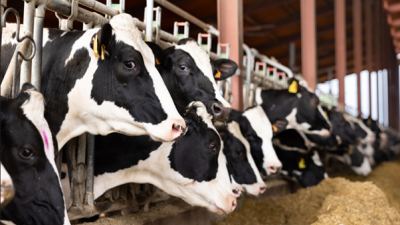Advancing mix quality for efficient ruminant feeding

It is no secret that the physical presentation of a ruminant ration is just as important as the ingredients that go into it. Data from InTouch has repeatedly shown that optimising ration presentation can increase milk production by 16% or daily liveweight gain by 200 grams per head per day.
Tim Kneale, U.K. InTouch Feeding Specialist, explains.
I do not claim to be Paul Hollywood, but it is really like baking a cake! If you do not put the right amount of ingredients in, or if you do not put it together in the right way, you will not get the end result the recipe promises. Moreover, the better-baked cake will get eaten more readily than the poorer one!
To put this into a farming context, there are three possible diets within ruminant nutrition:
- The diet formulated by the nutritionist (the recipe)
- The diet made or processed
- The diet actually eaten
Accuracy and consistency are key factors in ensuring a uniform chop length of forages and even distribution of concentrate.
The effects of poor physical ration presentation
Rations that are either over-processed and too fine or under-processed and too coarse present a challenge to cattle herd health and feed performance.
Some of the main challenges that arise from a poorly processed ration include:
- A drop in milk yield and butterfats
- A feed conversion efficiency drop
- Ruminal acidosis
Warning signs that ration presentation is not quite right
Here are four aspects that producers can keep an eye on to ensure ration presentation is right:
- Cows nuzzling and digging holes in the ration
- Long fibrous leftovers before the next feed
- Variable intakes and dung inconsistencies
- Inconsistency along the feed face
Feed fences or troughs tend to be quite long, and there is a lot of scope for feed and intake variation from start to finish. When assessing your final ration, take a sample from the start, middle and end to visually check for any inconsistencies. Look for differences in concentrate levels, forage chop length and sharp cut ends, not frayed, split ends.

Image: The difference in ration presentation from the start (pictured left) to the end (pictured right) of the feed trough/feed-out.
How to improve mix quality consistency
Farmers seeking to continuously improve and advance are being advised to look closely at how they process their ration. Here are some of the things you can control to achieve greater precision:
- When adjusting the number of cows, recalibrate each feed ingredient exactly. The InTouch system allows feed allocation to be altered while maintaining the chemical composition of the diet, ensuring a consistent energy and protein supply into the rumen.
- If using a paddle feeder, load liquids and smaller elements first. When using a paddle feeder, be mindful of the volume and how full the mixing chamber is — overloading the wagon will severely reduce the effectiveness of the mixing action, leading to an uneven distribution of feeds along the trough.
- If using a vertical feeder, load in the opposite order (liquids and smalls last). Vertical feeders are much more aggressive and have a reduced window for achieving the optimum mix quality — it is easy to overmix and destroy structural fibre within the ration.
- Ensure the processing time between each ingredient is measured and consistent.
Rumen function is key to maintaining milk production and cow health, so rumen conditions need to be consistent. If you are not maintaining or controlling the mixing/processing time of each ingredient, then variation can occur and have a negative effect on production.
Cows love consistency, and so health and performance are very dependent on each and every cow getting the same mouthful of feed every time she eats.
InTouch is designed to help farmers and operators make this happen. Think of it as a SatNav for your diet feeder, with round-the-clock technical support from the experts.
The weigh box on the side of the diet feeder has very few buttons and is very intuitive and simple to use. It tells the farmer step by step what feed mix to put in the machine and then records what was actually put in the machine. If something goes wrong or there is a deterioration in animal performance, the farmer gets a phone call, and our nutritionist changes the diet in real-time via the cloud. It is like having a nutritionist in the farmyard.
The weigh box collects exact data on what is being mixed for the animals. We can also call in the data from milk and beef production, so our nutritionists are able to correlate the diets with the performance of the animal and all the other animals on our system and give real-time advice to the farmer on improving performance.














